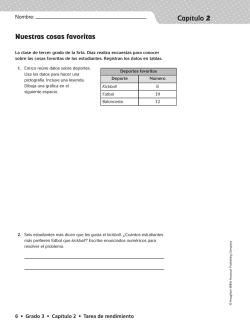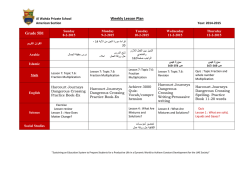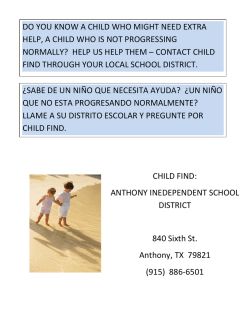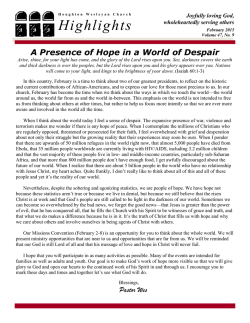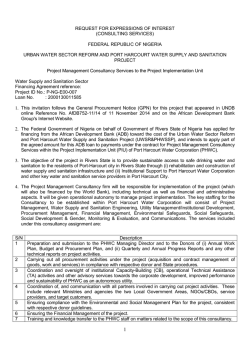
Dear Family, Sincerely, Your child`s teacher
Dear Family, Family Letter Content Overview Your child is familiar with multiplication from earlier units. Unit 3 of Math Expressions extends the concepts used in multiplication to teach your child division. The main goals of this unit are to: • Learn methods for dividing whole numbers up to four digits. • Use estimates to check the reasonableness of answers. • Solve problems involving division and remainders. Your child will learn and practice techniques such as the Place Value Sections, Expanded Notation, and Digit-by-Digit methods to gain speed and accuracy in division. At first, your child will learn to use patterns and multiplication to divide. Later, your child will learn to use the methods with divisors from 2 to 9. Then your child will learn to divide when there is a zero in the quotient or dividend and to watch out for potential problems involving these situations. Examples of Division Methods: Place Value Sections Method Your child may use whatever method he or she chooses as long as he or she can explain it. Some children like to use different methods. 60 + 5 6 = 66 330 30 - 300 - 30 30 0 Expanded Notation Method Digit-by-Digit Method 6 66 60 5qw 330 300 _ _ 30 - 30 _ 0 66 5qw 330 30 __ 30 30 __ 0 © Houghton Mifflin Harcourt Publishing Company Your child will also learn to interpret remainders in the context of the problem being solved; for example, when the remainder alone is the answer to a word problem. Finally, your child will apply this knowledge to solve mixed problems with one or more steps and using all four operations. If you have questions or problems, please contact me. Sincerely, Your child’s teacher Unit 3 addresses the following standard from the Common Core State Standards for Mathematics with California Additions: 4.NBT.6 and all Mathematical Practices. UNIT 3 LESSON 1 Divide With Remainders 33 Estimada familia: Carta a la familia Un vistazo general al contenido En unidades anteriores su niño se ha familiarizado con la multiplicación. La Unidad 3 de Math Expressions amplía los conceptos usados en la multiplicación para que su niño aprenda la división. Los objetivos principales de esta unidad son: • aprender métodos para dividir números enteros de hasta cuatro dígitos. • usar la estimación para comprobar si las respuestas son razonables. • resolver problemas que requieran división y residuos. Su niño aprenderá y practicará técnicas tales como las de Secciones de valor posicional, Notación extendida y Dígito por dígito, para adquirir rapidez y precisión en la división. Al principio, su niño aprenderá a usar patrones y la multiplicación para dividir. Más adelante, usará los métodos con divisores de 2 a 9. Luego, aprenderá a dividir cuando haya un cero en el cociente o en el dividendo, y a detectar problemas que pueden surgir en esas situaciones. Ejemplos de métodos de división: Secciones de valor posicional 60 + 5 330 30 - 300 - 30 30 0 6 66 60 5qw 330 300 _ _ 30 30 _ 0 Dígito por dígito 66 5qw 330 30 __ 30 __ 30 0 Su niño también aprenderá a interpretar los residuos en el contexto del problema que se esté resolviendo; por ejemplo, cuando solamente el residuo es la respuesta a un problema. Por último, su niño aplicará este conocimiento para resolver problemas mixtos de uno o más pasos, usando las cuatro operaciones. Si tiene alguna pregunta o comentario, por favor comuníquese conmigo. Atentamente, El maestro de su niño En la Unidad 3 se aplican los siguientes estándares auxiliares, contenidos en los Estándares estatales comunes de matemáticas con adiciones para California: 4.NBT.6 y todos los de prácticas matemáticas. 34 UNIT 3 LESSON 1 Divide With Remainders © Houghton Mifflin Harcourt Publishing Company Su niño puede usar el método que elija siempre y cuando pueda explicarlo. A algunos niños les gusta usar métodos diferentes. 6 = 66 Notación extendida Name 3-1 Date Class Activity ► Divide with Remainders The remainder must be less than the divisor. If it is not, increase the quotient. 3 5qw 23 -15 _ 8 no 4 R3 23 5qw - 20 _ 3 yes 8>5 3<5 8 87 9qw - 72 _ 15 no 15 > 9 9 R6 9qw 87 81 _ 6 yes 6<9 Divide with remainders. 1. 2qw 19 2. 7qw 50 3. 9qw 48 48 4. 5qw 19 5. 6qw 25 6. 3qw © Houghton Mifflin Harcourt Publishing Company Divide. Multiply to check the last problem in each row. 5 R4 9. 7qw 39 -_ 35 _ 4 27 7. 6qw 8. 4qw 30 43 10. 8qw 26 11. 5qw 12. 9qw 41 32 13. 5qw 21 14. 4qw 22 15. 3qw UNIT 3 LESSON 1 7⋅5+4= 35 + 4 = 39 Divide With Remainders 35 Name 3-2 Class Activity Date Content Standards 4.NBT.6 Mathematical Practices MP.1, MP.6 ► Multiplying and Dividing Complete the steps. 1. Sam divides 738 by 6. He uses the Place Value Sections Method and the Expanded Notation Method. a. Sam thinks: I’ll draw the Place Value Sections that I know from multiplication. To divide, I need to find how many hundreds, tens, and ones to find the unknown factor. Place Value Sections Method hundreds 00 6 + tens + 0 Expanded Notation Method ones 738 6qw 738 b. 6 × 100 = 600 will fit. 6 00 6 + × 200 = 1,200 is too big. 0 + 6qw 738 738 c. I have 138 left for the other sections. 6 × 20 = 120 will fit. 6 × 30 = 180 is too big. 1 00 0 + 138 738 -600 138 d. 6 × 3 = 18 1 00 6 36 + 20 + = 738 -600 138 -120 18 138 18 0 UNIT 3 LESSON 2 20 100 6qw 738 - 600 __ 138 120 __ 18 Relate 3-Digit Multiplication to Division © Houghton Mifflin Harcourt Publishing Company 6 + 100 738 6qw - 600 __ 138 Name 3-2 Date Class Activity ► Practice the Place Value Sections Method Solve. Use Place Value Sections Method for division. The sidewalk crew knows that the new sidewalk at the mall will be 3,915 square feet. It will be 9 feet wide. How long will it be? 400 + 9 ft 30 + 5 3,915 -3,600 315 -270 45 -45 315 45 0 = 435 3. Pens are packaged in boxes of 8. The store is charged for a total of 4,576 pens. How many boxes of pens did they receive? © Houghton Mifflin Harcourt Publishing Company 00 + 0 + = 5. A party planner has 834 small flowers to make party favors. She will put 3 flowers in each party favor. How many party favors can she make? + UNIT 3 LESSON 2 + = 2. The sidewalk at the theater will be 2,748 square feet. It will be 6 feet wide. How long will it be? 00 + 0 + = 4. A factory has 2,160 erasers. They package them in groups of 5. How many packages of erasers does the factory have? + + = 6. An artist has 956 tiles to use in a design. He plans to arrange the tiles in group of 4 tiles. How many groups of 4 tiles can he make? + + = Relate 3-Digit Multiplication to Division 37 Name 3-3 Class Activity Date Content Standards 4.NBT.6 Mathematical Practices MP.2, MP.7, MP.8 ► 2-Digit and 4-Digit Quotients Solve. Use the Place Value Sections and the Expanded Notation Methods for division. 1. 20 + 8 = 28 252 72 9 - 180 - 72 72 0 ,000 + 3. 8 38 00 + 6 0 + 7,722 UNIT 3 LESSON 3 = 6qw 162 = 8qw 8,984 00 + 0 + = 3qw 7,722 Discuss 2-Digit and 4-Digit Quotients © Houghton Mifflin Harcourt Publishing Company 3 9qw 252 8,984 ,000 + 4. 0+ 162 2. 3-3 Name Date Class Activity ► Practice © Houghton Mifflin Harcourt Publishing Company Divide. 6. 4qw 868 7. 6qw 5,142 332 9. 4qw 10. 7qw 1,617 11. 7qw 939 4,276 12. 2qw 13. 6qw 2,576 14. 7qw 441 15. 9qw 3,735 16. 7qw 406 17. 3qw 9,954 UNIT 3 LESSON 3 8. 3qw 4,395 Discuss 2-Digit and 4-Digit Quotients 39 3-4 Name Date Class Activity ► Practice Divide. 128 7. 8qw 928 8. 8qw 9. 3qw 716 10. 4qw 4,596 11. 4qw 982 12. 3qw 6,342 13. 8qw 578 14. 5qw 1,155 15. 6qw 3,336 16. 7qw 672 17. 3qw 4,152 40 UNIT 3 LESSON 4 Digit-by-Digit Method © Houghton Mifflin Harcourt Publishing Company 6. 5qw 965 UNIT 3 Name Date Review/Test 1. For 1a–1d, choose True or False to indicate if the statement is correct. 1a. 245 ÷ 6 = 40 R5 True False 1b. 803 ÷ 2 = 400 True False 1c. 492 ÷ 7 = 69 R7 True False 1d. 355 ÷ 5 = 71 True False 2. A train has a total of 216 seats in 3 cars. Each train car has the same number of seats. How many seats are in each train car? ___________ seats 3. Kayla puts together gift boxes of fruit to sell at her fruit stand. She places exactly 6 pieces of fruit in each box. She only sells full boxes of fruit. Part A © Houghton Mifflin Harcourt Publishing Company Kayla has 256 apples. How many boxes of fruit can she fill? Explain how you found your answer. Part B Kayla has enough peaches to fill 31 gift boxes. How many apples and peaches did Kayla put in gift boxes to sell at her fruit stand? Show your work. UNIT 3 TEST 41 Name UNIT 3 Date Review/Test 4. Margaret is dividing 829 by 4. Part A Explain why Margaret needs to write a zero in the tens place of the quotient. Part B How would the digit in the tens place of the quotient change if Margaret were dividing 829 by 2? 6. What is 945 ÷ 5? 42 A 189 C 199 B 190 D 209 UNIT 3 TEST © Houghton Mifflin Harcourt Publishing Company 5. A storage shelf where Carmen works can hold about 165 pounds. The storage shelf can hold 8 boxes of car parts. About how many pounds does each box weigh? Does this problem require an exact answer or an estimate? Then find the answer. UNIT 3 Name Date Review/Test 7. Divide 4,124 by 2. 8. Joshua carried 52 loads of sand to make a play area. Each load weighed 21 pounds. How many pounds of sand does Joshua use to make the play area? Use the numbers and symbols on the keypad to write the expression needed to solve this problem. Then solve the problem. 7 8 9 4 5 6 1 2 3 0 ÷ × expression: ____________ ________________ pounds 9. There are 118 boys and 121 girls signed up for a volleyball league. The coaches first make teams of 9 players and then assign any remaining players to make some of the teams have 10 players. © Houghton Mifflin Harcourt Publishing Company Part A How many teams of 10 players will there be? Explain. Part B How many teams of 9 players will there be? Explain. UNIT 3 TEST 43 Name UNIT 3 Date Review/Test 10. A florist has 2,388 flowers to make into small bouquets. She wants 6 flowers in each bouquet. How many bouquets can she make? Complete the Place Value Sections to solve. 00 + 0 + = flowers 11. Divide 7,433 by 7. Show your work. 44 39 R3 _ 12a. 6⟌ 297 Yes No 814 _ 12b. 4⟌ 3,256 Yes No 228 R5 _ 12c. 8⟌ 4,229 Yes No 1,007 R1 _ 12d. 8⟌ 5,136 Yes No UNIT 3 TEST © Houghton Mifflin Harcourt Publishing Company 12. For numbers 12a–12d, choose Yes or No to tell if the quotient is reasonable. UNIT 3 Name Date Review/Test 13. Hailey finds 24 seashells on Friday and another 38 seashells on Saturday. She shares as many of the seashells as she can equally among herself and 3 friends. She keeps the leftover seashells for herself. How many seashells does Hailey get? Show your work. © Houghton Mifflin Harcourt Publishing Company 14. Ethan has 203 geodes to put into display cases. Each case holds 8 geodes. How many cases does Ethan need to hold all the geodes? Explain how you know. 15. Select one number from each column to make the equation true. 5,155 ÷ 3 = Quotient 1,715 1,717 1,718 1,720 UNIT 3 TEST ■R■ Remainder 1 2 3 4 45 UNIT 3 Name Date Review/Test 16. Julie divided 2,526 by 6 and found a quotient of 421. For 16a–16c, choose True or False to tell if the statement is correct. 16a. 2,400 ÷ 6 = 400, so 421 makes sense. True False 16b. 2,526 ÷ 6 = 421 R5 True False 16c. 421 × 6 = 2,526, so 421 makes sense. True False 17. Which expression has a quotient of 400? Circle all that apply. 1,600 ÷ 4 2,000 ÷ 5 400 ÷ 4 3,600 ÷ 9 18. Kyle wrote his first step in dividing 3,325 ÷ 5 using the Expanded Notation Method. 500 _ 5⟌ 3,325 - 2,500 __ 825 Part A Write a number sentence that will calculate a reasonable estimate for the quotient of 3,325 ÷ 5. Part B 46 UNIT 3 TEST © Houghton Mifflin Harcourt Publishing Company Explain how Kyle’s division work would be different if he had used your estimate instead of 500 as his first step? Then find the exact quotient of 3,325 ÷ 5.
© Copyright 2025
